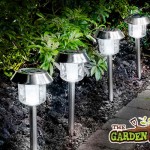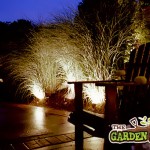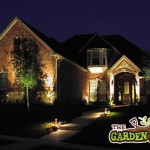Using lights in your Garden is a great way of adding colour and interest. Lights provide and focal point and allow you to extend the use of your garden into the night. While water can be considered an essential feature of a garden, lighting too has become an element that can not be omitted from the complete garden
- Solar Lights
- Lighting Shrubs
- Spot lights
While gardens can be full of colour during the day, at night time they take on a whole new character when lit. This means that you can get a lot more out of your garden and entertain well into the wee hours of the morning.
When choosing garden lights for your garden there are a number of things you can consider:
Solar or electric: Originally solar lights were considered cheap and short lived in the garden. But these days solar lights have become a popular and excellent way of adding light to your garden without the added cost and hardship of rewiring. Solar lights can simply be pushed or slotted into place where ever you need them and they will offer light during darkness throughout the year. To ensure that you are getting a good quality solar light ensure that the lights are:
- Stainless steel and not plastic casing is important for a more durable and long lasting garden light
- The bulbs should be LED and not filament bulbs which emit a lower quality of light
- The battery should be Nickel Metal Hydride (NiMH) or Nikel Cadmium as these offer the highest efficiency
- lastly, check the quality of the wiring & connections ensuring a quality build and sturdy product
Position of lights: For every position in the garden there is a garden light designed to suit:
- Drives & path; Solar marker lights or light posts are ideal for lining the edge of drives & paths. These lower lights will emit a low intensity of light and simply make edges more prominent
- Walls: Wall are a good feature to light in a garden. By lighting a wall you can really give a garden a sense of space as the boundaries are highlighted making those in the garden more aware of their space. Wall lighting allow adds an element of height to a garden again adding to the sence of space. Garden wall lights can be fixed to walls, with light highlighting the pattern in the wall. Alternatively low spot lights can be positioned and pointed up towards a garden wall to similar effect.
- Shrubs & trees: while wall lights offer a clinical and defined sense of space to a garden, lighting up shrubs and especially large trees can create a more fluid and softer lighting scheme. Specimen plants such as very large trees can be light up with awesome effects. When doing so, it is best to let one garden light create the impact and best not to spoil that with smaller lighting around the garden
Other plants that are suited to lighting up with spot garden lights include:
- Dicksonia Antartica
- Pheonix Americana
- Chamerops Humilis
- Fatsia Japonica
- Acer palmatum range
- Juniperus squamata
- Thuja Occidentallis


